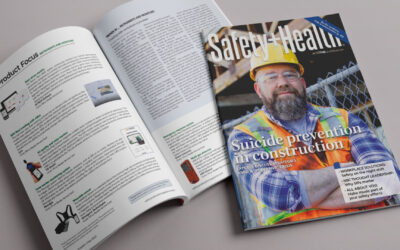Safety is the right thing to do — we all know that.
But what if it’s also one of the smartest things you can do for your business?
At Strongarm, we believe injury prevention isn’t just a moral obligation or a compliance requirement—it’s a strategic investment. Our customers who invested in proactive safety programs saw not just fewer injuries but also higher productivity, lower turnover, and stronger bottom lines.
This post is all about return on investment — the ROI of safety. And we’re here to show you that focusing on injury reduction pays off faster and more meaningfully than most businesses expect.
Why ROI Matters in Safety Conversations
Safety professionals don’t need to be convinced that protecting workers is important—they live and breathe it. But business leaders, finance teams, and executives often need something more concrete—something they can plug into a spreadsheet, something that shows impact.
That’s where ROI comes in.
The truth is that most injuries come with costs far beyond the medical bills. They ripple outward:
- Lost time and productivity
- Overtime for coverage
- Lower morale
- Increased turnover
- Higher insurance premiums
- OSHA violations and penalties
When you reduce injuries, you reduce all of those costs at once.
What Injuries Really Cost
According to the National Safety Council, the average cost of a single workplace injury in 2024 was $41,757—and that’s just the direct costs. The total can be far higher when you include turnover, downtime, and reputational damage.
What are the most common types of injuries among frontline workers?
- Sprains and strains
- Lower back injuries
- Shoulder and knee pain
These are often caused by repetitive motion, poor lifting form, and fatigue—exactly the kinds of risks our SafeWork System is designed to detect and reduce.
When you multiply $41,000 by even a handful of avoidable injuries annually, the ROI math starts to speak for itself.
The Business Case for Risk Reduction
At Strongarm, we work with companies across industries—logistics, warehousing, grocery, retail, and manufacturing—and we consistently see major gains when safety is treated as a priority.
Here’s what we’ve learned from the organizations that are getting safety right:
1. Injury Reduction Happens Quickly
You don’t have to wait years to see results with the right tools. Our customers who deploy the complete SafeWork System (wearable sensors, movement-based coaching, and actionable dashboard data) see a 35–50% drop in risky movements within 30 days and a 40–65% reduction in injuries within the first year.
That kind of impact doesn’t just feel good. It pays off:
- Fewer workers’ comp claims
- Lower insurance premiums
- Fewer lost-time incidents
- Less need for temp labor or overtime coverage
And it’s just the beginning.
2. Retention Improves When Workers Feel Safe
Something else that doesn’t always appear on an injury report is that when people don’t feel safe, they leave. Turnover is incredibly expensive, especially in frontline roles, where the average onboarding cost can reach $4,000–$5,000 per worker.
Our customers have seen a measurable drop in attrition rates — sometimes by as much as 20% — after implementing the SafeWork System. And it makes sense: when workers know their employer is actively investing in their safety and well-being, they stick around.
In an industry where hiring and retention are ongoing challenges, that’s a massive win.
3. Productivity and Quality Go Up
Safer workers are healthier workers. They’re not pushing through pain. They’re not holding back to protect a sore back or stiff shoulder. They’re moving confidently, efficiently, and effectively.
We’ve seen teams hit peak productivity targets more consistently, with fewer errors, when they reduce injury risk. Good movement is good ergonomics, leading to faster, smoother work.
It’s a ripple effect: better movement leads to fewer injuries, less fatigue, and higher productivity.
Let’s say you operate a regional distribution center with 300 frontline workers. Last year, you recorded 15 injuries that led to medical attention or time off work. You estimate that each incident costs your business around $45,000 in direct and indirect expenses.
That’s $675,000 in preventable costs.
Now, imagine you will implement the SafeWork System. Your team adopts it well — thanks to on-sensor coaching and a clear rollout plan — and by year’s end, you’ve reduced your recordable injuries by 60%, avoiding nine incidents.
That’s $405,000 in costs saved — in one year.
If your SafeWork program costs less than that to implement (and it almost certainly does), your ROI will be positive in year one and likely to grow in year two and beyond as your culture strengthens and your team becomes even more movement-aware.
Culture Change Is the Ultimate ROI Multiplier
Here’s something we can’t put a dollar value on — but it might be the biggest payoff of all: safety culture.
When a worker gets a gentle vibration from their sensor reminding them to lift with better form — and they listen — that’s one less risky movement. When a peer encourages that behavior, it spreads. When a supervisor pulls up the SafeWork Dashboard and celebrates a drop in high-risk movements, it reinforces the cycle.
Sites frequently transform from reactive to proactive:
- Workers competed for the best movement scores.
- Teams challenged each other to reduce risk.
- Supervisors used dashboard data to coach, not correct.
This cultural shift is hard to fake and even harder to undo. Once people know what “better” looks like, they don’t go back.
What Makes the ROI of Strongarm’s SafeWork System So High?
We built SafeWork to be simple to adopt, easy to scale, and impactful from day one. Here’s why it delivers strong ROI:
- Real-time feedback: Sensors alert workers as they move, helping correct risky behaviors.
- On-device training: With our new Session Summaries feature, short movement-correcting videos appear directly on the sensor, giving workers instant guidance without extra meetings or apps.
- Actionable data: Our dashboard turns movement patterns into coaching opportunities, performance insights, and injury predictors.
- Low lift for managers: We designed the system to require minimal effort from safety and operations leads — because we know you already have a lot on your plate.
- Fast time to value: Most customers see measurable improvements within the first 4–6 weeks.
ROI Isn’t Just for the Boardroom — It’s for the Breakroom
Let’s not lose sight of why this all matters.
The frontline worker who goes home without pain, who plays with their kids after work, who doesn’t need physical therapy or lose wages because of a back injury — that’s ROI, too.
When you prevent an injury, you don’t just save a claim — you protect a person.
In our experience, companies that focus on that kind of ROI also tend to do well on the spreadsheet.
Ready to See the ROI of Safety for Yourself?
If you’re ready to move beyond check-the-box safety programs and start seeing real returns—in your injury rates, retention metrics, and operational performance—we’d love to show you how SafeWork works.
Let’s build a business case together. One that works for your team, your leadership, and the people who run your business daily.




